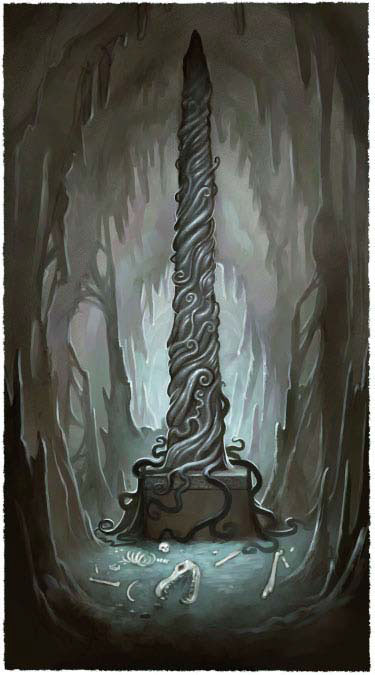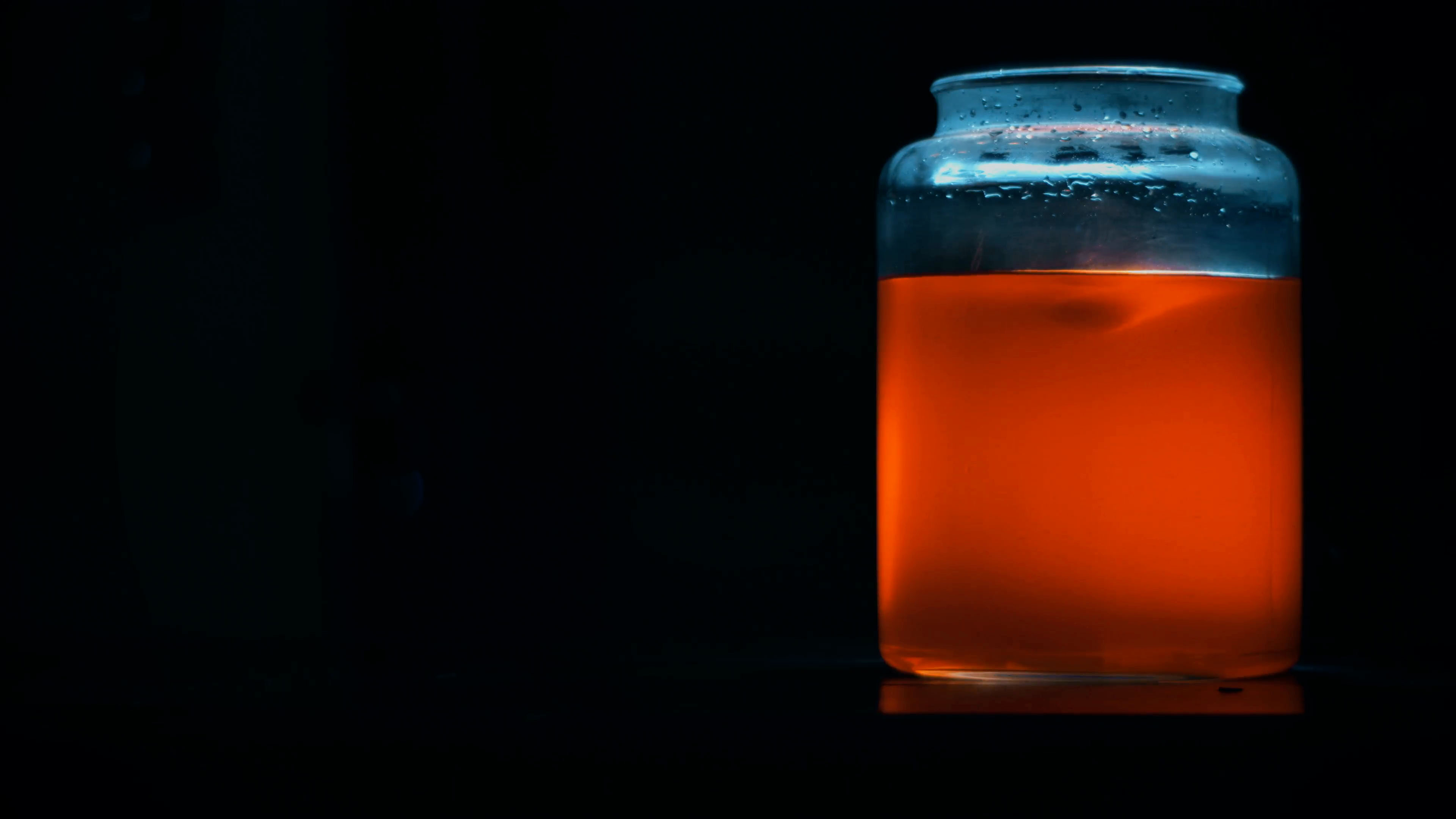Session 14C: The Temple of Ebony
They decided to start with the hall to the east: The iron doors opened onto a large room paved in glistening ebony. It rose in three tiers. Two horrific statues stood in the corners of the second tier. To the left a twisting pillar of coiled tendrils and to the right a squat monstrosity. In the center of the third tier, at the top of the room, there was a slab of black ebony…
One of the cool things about a well-designed dungeon is that you can never be entirely sure about what sequence the PCs will encounter content in. It’s like tossing all of your scenes into a blender: Stuff will end up juxtaposed in ways you never anticipated, prompting all manner of creative interactions and dynamic consequences.
For example, the very first room of the Laboratories of the Beast features three exits. Two of these expand outwards in ever-growing, heavily xandered loops. The third exit – which PCs heading straight ahead through the initial chamber would pass through – led to a single room: The temple of the dark gods described near the beginning of this week’s journal entry.
In designing the dungeon this way, I had lightly assumed that this temple would be encountered relatively quickly: It was right at the entrance! As you can obviously see, this ended up not being the case and the PCs actually spent prodigious amounts of time exploring this dungeon complex over the course of several expeditions before finally entering the temple.
As a result, they entered the temple dedicated to the dark gods after they’d already encountered Morbion, who worshipped one of those dark gods. The intended foreshadowing, therefore, was completely inverted: Rather than, “Oh shit, here’s one of those dark gods!” it became, “Oh shit! That dark god is a bigger and older deal than we realized!”
… except the PCs didn’t actually connect the dark gods of the temple to the dark god worshipped by Morbion, so the whole thing actually became a lingering mystery rather than being thematically connected.
With all that being said, of course, the design of a dungeon DOES impart some degree of sequencing, some or most of which will stick. So this is something you want to give some thought to when you’re designing things.
CHOKEPOINTS: There are points, even in a xandered design, where certain areas will lie beyond a chokepoint. For example, it was basically impossible for the PCs to reach the Laboratory of the Beast without first passing through the Complex of Zombies. Or, “If they go to Shardworld, it’s because they definitely passed through the Portal of Shattered Obsidian.” That sort of thing.
If there’s something that the PCs should know or experience before being in a given location, place it in a chokepoint they have to pass through in order to reach that location.
Note that chokepoints can also be non-physical: You need to find the gillweed gardens before you can extensively explore the underwater portion of the complex. Or you need to find the mending stone before you can use the damaged portal without ripping yourself into a thousand shards.
Chokepoints also don’t have to boil down to a specific chamber or door or the like. They can be more abstract than that: The PCs don’t have to pass through a specific room to get to the Lilac Caverns, but they do have to pass through the Golem’s Workshop complex. I sometimes think of a dungeon has having different “phases” or regions”.
How does the idea of establishing a particular piece of knowledge or experience sync up with this concept of a phased chokepoint? Well, think about the Three Clue Rule. You want them to know that the Golem was obsessed with cloning his creator before they find the creator’s body in the Lilac Caverns? Well, every facet of the workshop can (and should!) reflect that obsession in an almost fractal way, right?
In other words, rather than locking yourself down into a specific “this is the experience they need to have”, you can can kind of spew “experience DNA” everywhere and let the actions of the PCs slowly assemble a custom experience of their own out of it.
NON-SYMMETRICAL APPROACHES: Thinking of things strictly in an “experience A before B” way is a trap, though, and you should avoid it. When you’re looking at a key room (or suite of rooms) and thinking about how it’s structured, you can also embrace the fact that there are multiple paths to that area.
One of the things you can do to make your dungeon a richer and more interesting environment is to specifically make the experience of the area different depending on which direction you approach it from. A really easy example of this is entering a Goblin Princess’ bedchamber by fighting your way through the guards outside vs. slipping in through the forgotten secret door at the back of her boudoir.
DON’T THINK ABOUT IT: The other thing to keep in mind is that you don’t actually have to try to keep all of this stuff in your head while you’re designing the dungeon. In fact, it can become way too easy to start obsessing about this, at which point you can end up with a kind of hyperthyroidic version of My Precious Encounters™, except now you’re trying to carefully cultivate specific experiences by somehow conceptually corralling an incredibly complex and dynamic scenario.
You’ll generally be happier (and have better games) if you don’t rely on things playing out in a specific sequence. And, in reality, it’s not that hard: Use situation-based design as your primary design stance and things tend to work out. This is really the same thing as Don’t Prep Plots: Don’t prep pre-packaged experiences, prep situations.
So why bring up dungeon sequencing at all? Because it WILL have an effect on how a scenario plays out, so you shouldn’t blind yourself to that or simply leave it up to blind chance. I’m just saying it should be used at a broader, more conceptual level and primarily as a diagnostic tool rather than the primary motivation for your design.
For example, consider the Goblin Caverns of the Ooze Lord scenario that ran from Session 10 through Session 13. I designed the scenario like this:

Thus, the PCs encounter the goblins suffering the ooze infection before traveling to the ooze caverns from whence the ooze infection originates.
But I could have just as easily designed the scenario like this, with virtually no changes to the local topographies:

So that when the PCs come to the checkpoint manned by the (as yet unnamed) Itarek, as described in Session 10D, they would have the choice of turning left to the clan caverns or turning right to the ooze caverns.
(This would also change the logic of the world somewhat: In the scenario-as-designed, the goblins are – wittingly or otherwise – guarding the surface world against the Ones of Ooze. In this alternate version of the scenario, it’s far more likely that the PCs will encounter ooze-goblins coming up through the Laboratory of the Beast and infiltrating Ptolus. Which is what I mean by a situation-based design stance, right? But I digress.)
You could even go one step farther with:

So that the PCs enter the ooze caverns, probably fight Morbion, and only later discover the goblins who were being victimized by them.
(This wouldn’t work at all with the original seed for the adventure, which posited that the goblins in Grayson House were refugees who fled to the surface to escape the growing threat of the ooze-goblins. We could probably just swap it up, though, and have them instead be ooze-goblins who Morbion sent to the surface as initial scouts. But I digress again.)
It shouldn’t be too difficult to see how each of these macro-sequences would fundamentally change how the resulting scenario would play out at the table, right?
The specifics, of course, are all still up in the air: As I’ve discussed in the past, I didn’t anticipate the PCs forming a long-term alliance with the Clan of the Torn Ear. But that option wouldn’t have even been on the table if I’d sequenced the dungeon in a different way.
And that’s what you have to be mindful of: Not trying to pre-control outcomes, but figuring out what the most interesting chaotic bundle of unrealized potentials is and bringing that into play.






 In the center of the third tier, at the top of the room, there was a slab of black ebony with the appearance of an altar.
In the center of the third tier, at the top of the room, there was a slab of black ebony with the appearance of an altar.












